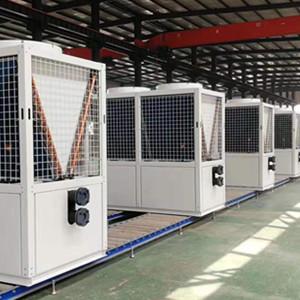Air Source Heat Pump Amps
The kW output and electrical load of a heat pump are important when choosing a heat pump, and efficiency is also an important reference for customers to make a heat pump purchase choice. Let us explain to you.
Electrical load
In the case of a heat pump, the electrical load is called a fuse/breaker sizing and needs to be in place for the heat pump to operate safely. Most heat pumps come in 3 breaker sizes: 16amp, 20amp and 32amp, the breaker size determines the kW output/size of the heat pump. The bigger the breaker, the bigger the heat pump. Note that in almost all cases this circuit breaker size will not take into account a domestic hot water tank immersion (if installed), as the immersion is expected to be powered by its own circuit and therefore generate its own circuit protection.
Now that we know what we mean when we refer to electrical loads, why is it important to choose a heat pump? If you were to investigate an older property, you might calculate that it has a 12kW heat load and therefore needs a heat pump that requires at least 32amp power. If this older property had a 60 amp mains fuse, you might find it difficult to use such a large heat pump on this property. Take the 60 amp fuse, we need to subtract 32 amps for the heat pump supply, then maybe 16 amps for the 3kW immersion heater supplying the domestic hot water tank, as well as power for the circulation pump and 2 port valve etc. . Soon we have reduced the 60 amp main fuse to 12 amp current draw. If the owner has a 3kW kettle that requires a 13amp fuse, when the heat pump, immersion heater and kettle are running at the same time, then the property will technically be in a negative amp situation. In this case, either adding insulation to the property (allowing for a smaller heat pump), upgrading the home's main fuse (perhaps up to 100A), or mixing a heat pump and a fossil fuel boiler (allowing a smaller heat pump to address most of your heating needs) could be both related solutions.
If we compare this to a new, well-insulated property, we see that it's not a big deal. Assuming a load of 5kW (16amp supply), plus immersion heater in domestic hot water tank (16A) plus circulation pump, etc. (3A) = 35Amps. New houses tend to have 100A main fuses, so the 35A required for the heat pump system leaves a lot of extra capacity for the rest of the 100A main fuse (65A in this case).

Efficiency
When we talk about efficiency in the context of heat pumps, we are talking about how much thermal energy a heat pump can transfer for a given electrical input. Divide the former by the latter to get the efficiency, that is, 5kW of thermal energy outputting 1.5kW of electrical energy equals 330% efficiency.
How we call efficiency has changed over the years. Many months ago, in the early days of heat pumps, we had COP (Coefficient of Performance). In fact, this is a snapshot of the efficiency of the heat pump at a specific ambient and flow temperature, i.e. 7°C outside temperature and 35°C flow temperature will give you an efficiency of 500% or 5. While this is useful when comparing different heat pumps with known baseline data early on, it's not particularly useful when trying to understand a year's efficiency of a heat pump.
Next is SPF (seasonal performance factor). Since they are not specific to outside/ambient temperature, they are great for indicating the efficiency of a heat pump at a specific flow temperature, i.e. a 45°C heating loop flow temperature would be equivalent to a possible space heating SPF 3 for an air source heat pump. Unfortunately, since they are not manufacturer-specific, their usefulness is limited to that.
Today, we have SCOP (seasonal coefficient of performance). SCOP is best described as an annualized COP (Coefficient of Performance). While the COP is at a specific outdoor/ambient and flow temperature, the SCOP takes into account more factors and is compliant with European Standard EN14511. This is arguably the most accurate way to compare the different efficiencies of air source heat pumps. You can find SCOP data for each MCS certified heat pump on the MCS Certification website.
To really understand the difference between COP and SCOP, you can describe them in terms of car mpg. You can think of COP very broadly as highway driving, or driving around town. Neither driving style will necessarily reflect the efficiency you'll see in a year, as you may be driving a mix of the two. SCOP, on the other hand, takes some information from highway driving and round-the-city driving, so you can get a closer reflection of the efficiency or MPG you might expect to see.
You might be surprised to learn that what was considered a superstar of very high COP 10 years ago is now starting to be seen more and more as a number for SCOP/annualized efficiency. The COP of air source heat pumps was very high 10 years ago, maybe 500% or 5. Over the past 12 months, we've seen devices such as Midea's M-Thermal series have an SCOP of 5.03 or 503% C flow temperature at 35°. A SCOP like this is a huge leap forward in closing the gap between air-sourced and ground-source heat pumps.
Contact us
We hope this helps you help your customers choose the right heat pump for them. Please continue to follow our Weibo. We'll update with more expertise on air source heat pumps.





